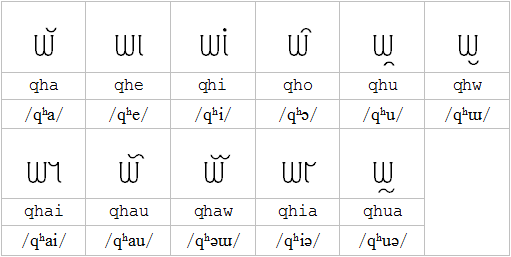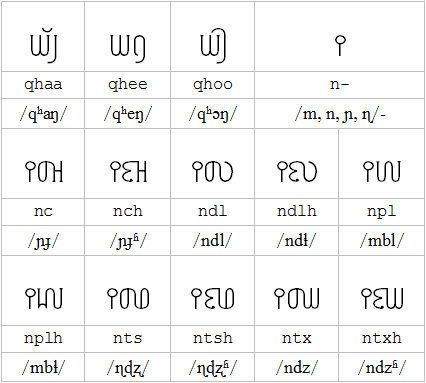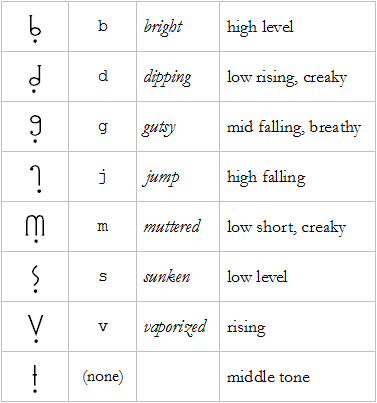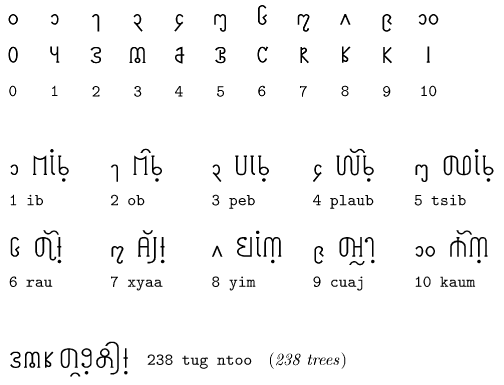This is an alternative to the RPA (Romanized Popular Alphabet system of Smalley, Bertrais and Barney, 1953). The aim was to create a script for Mong/Hmong and possibly Miao, visually related to other Southeast Asian scripts.
The design is based mainly on Pallava, the ancient South Indian script which was the parent of almost all scripts of SE Asia. In addition, some variations and innovations found in more recent script-forms have been incorporated. Some phonetic ideas from the RPA have been retained. An aesthetic similar to the home-grown (but daunting) Pahawh-Hmong alphabet was also in mind. In RPA, the script would be named Moob tshiab “new Mong”.
Notable features
- Most words (ie. non-compound) are a single syllable, consisting of consonant + vowel + tone.
- The many consonants (including lateral-release, pre-nasalized, pre-aspirated and post-aspirated phonemes) each have a single glyph, except for 10 listed later which use a nasalization prefix.
- Some complex phonemes take the form of ligatures (two or more glyphs merged into one).
- The vowel signs are written above, below or within the gap between consonant and tonal marker.
- Like the RPA, tones are written after the consonant-vowel figure. Unlike the RPA, the ‘middle’ tone is also marked.
- Gaps appear in the script only between phrases. The dots of the tonal markers help to pace out the words within a phrase.
- Glyphs exclusive to White Hmong and to Green Hmong are included.
Primary consonants
Here and below, each glyph is given with the RPA and IPA equivalents. The last glyph is a glottal plosive, used to carry initial vowels.
Vowels
Here the consonant /qh/ is used to display the relevant vowel mark in position.
Nasalization markers
There are 3 possibilities for post-nasalized vowels, shown here with the consonant /qh/. The ‘pre-nasal’ marker /n-/ is a stand-alone prefix form. Some simpler consonant-glyphs have the circular symbol already fixed to their top (see above). For the already complex cluster phonemes, the stand-alone prefix is used.
Tonal markers
As in RPA, the tone markers come at the end of the syllable. This is a less cluttered method than that used in other tonal scripts of the region. The letters of RPA remain, but are more symbolic than their Latin form. Each tone marker also has an optional dot below, which helps break up phrases into syllables, both for clarity and a visual sense of rhythm. The third column has a suggested mnemonic based on the tone-letter.
Numerals
Two forms are suggested here. The first is a generic form of a Tai/Mon system. The second is simply borrowed from the Pahawh-Hmong system.
Sample text
Transliteration into RPA:
Nyob rau ntu no, peb yuav los xyuas txog ntawv Hmoob.
Hmoob muaj puas-tsawg hom ntawv, lawv zoo li cas,
hom ntawv twg yog hom Hmoob siv ntau tshaj plaws thiab
hom teg thiaj yuav nuaj txiaj-ntsim ntau rau Hmoob,
peb yuav muab txheeb-xyuas kom tseeb rau hauv no ...
(This short extract from an article at www.hmongnet.org by Yeeb Nyiaj-sua Lis.)
A version of this page can be found on
Omniglot,
and at the
Hmong Language online encyclopedia.
|
From my paper “A New Script for the Mong Language,
Based on a Theoretical Generic Southeast-Asian Orthographic Model”. |
[A commercial-grade font is also under development. I welcome any feedback from current users of this script to “editor@skyknowledge.com.” A handy input method for New Mong is also available on request.]







